Smalls Progress in th(
Page 52
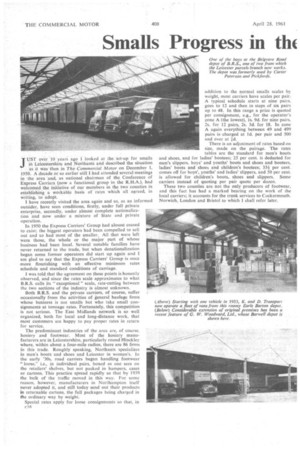
Page 53
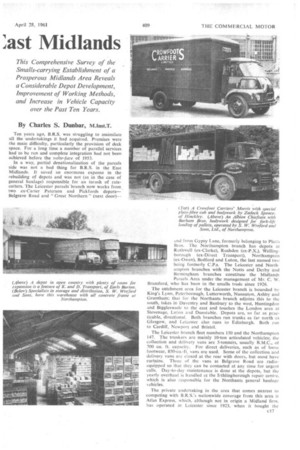
Page 54
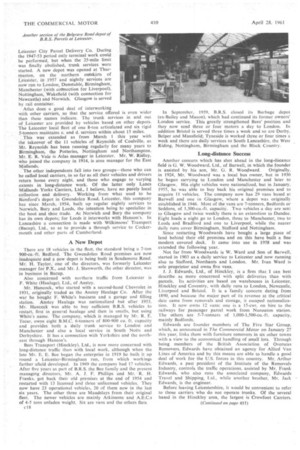
Page 57
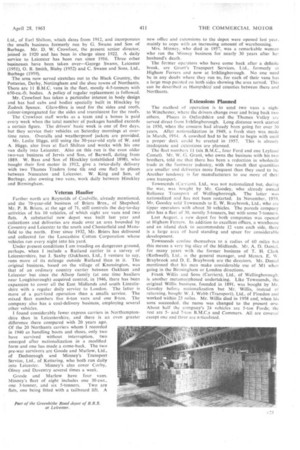
Page 58
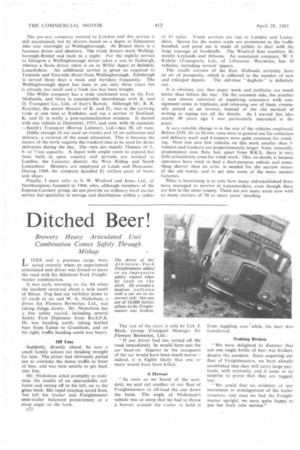
If you've noticed an error in this article please click here to report it so we can fix it.
:ast Midlands
This Comprehensive Survey of the Smalls-carrying Establishment of a Prosperous Midlands Area Reveals a Considerable Depot Development, Improvement of Working Methods, and Increase in Vehicle Capacity over the Past Ten Years.
By Charles S. Dunbar, M.Inst.T.
JUST over 10 years ago I looked at the set-up for smalls in Leicestershire and Northants and described the situation as it was then in The Commercial Motor on December 1, 1950. A decade or so earlier still I had attended several meetings in the area and, as national chairman of the Conference of Express Carriers (now a functional group in the R.H.A.), had welcomed the initiative of our members in the two counties in establishing a workable basis of 'rates which all agreed, in writing, to adopt.
I have recently visited the area again and so, as an informed outsider, have seen conditions, firstly, under full private enterprise, secondly, under almost complete nationalization and now under a mixture of State and private operation.
In 1950 the Express Carriers' Group had almost ceased to exist; the biggest operators had been compelled to sell out and so had most of the smaller. All that were left were those, the whole or the major part of whose business had been local. Several notable families have never returned to the trade, but when denationalization began some former operators did start up again and I am glad to say that the Express Carriers' Group is once more flourishing with an effective minimum rates schedule and standard conditions of carriage.
I was told that the agreement on these points is honestly observed, and since the rates scale approximates to what B.R.S. calls its " exceptional " scale, rate-cutting between the two sections of the industry is almost unknown.
Both B.R.S. and the private carriers, of course, suffer occasionally from the activities of general haulage firms whose business is not smalls but who take small consignments at tonnage rates. Fortunately, this competition is not serious. The East Midlands network is so well organized, both for local and long-distance work, that most customers are happy to pay proper rates in return for service.
The predominant industries of the area are, of course, hosiery and footwear. Most of the hosiery manufacturers are in Leicestershire, particularly round Hinckley where, within about a four-mile radius, there are 86 firms in this trade. Roughly speaking, Northants specializes in men's hoots and shoes and Leicester in women's. In the early '30s, road carriers began handling footwear "loose," i.e., in individual pairs, boxed as one sees on the retailers' shelves, but not packed in hampers, cases or cartons. This practice spread rapidly so that by 1939 the bulk of the traffic moved in this way. For some reason, however, manufacturers in Northampton itself never adopted it, and still today send out their products in returnable cartons, the full packages being charged in the ordinary way by weight.
Special rates apply for loose consignments so that, in c 16 addition to the normal smalls scales by weight, most carriers have scales per pair. A typical schedule starts at nine pairs, goes to 12 and then in steps of six pairs up to 48. In this range a price is quoted per consignment, e.g., for the operator's zone A (the lowest), Is. 9d. for nine pairs. 2s. for 12 pairs, 2s. 3d. for 18. In zone A again everything between 49 and 499 pairs is-charged at Id. per pair and 500 and over at 1d.
There is an adjustment of rates based on size, made on the pairage. The rates tables are the standard for men's boots and shoes, and for ladies' bootees; 25 per cent, is deducted for men's slippers, boys' and youths' boots and shoes and bootees, ladies' boots and shoes and children's bootees; 331 per cent. comes off for boys', youths' and ladies' slippers, and 50 per cent. is allowed for children's boots, shoes and slippers. Some carriers instead of quoting per pair quote per dozen.
These two counties are not the only producers of footwear, and this fact has had a marked bearing on the work of the local carriers; it accounts for the trunk services to Cockermouth, Norwich, London and Bristol to which I shall refer later. Ten years ago, B.R.S. was struggling to assimilate all the undertakings it had acquired. Premises were the main difficulty, particularly the provision of deck space. For a long time a number of parallel services had to be run and complete integration had not been achieved before the volte-face of 1953.
In a way, partial denationalization of the parcels side was not a had thing for B.R.S. in the East Midlands. It saved an enormous expense in the rebuilding of depots and was not (as in the case of general haulage) responsible for an inrush of ratecutters. The Leicester parcels branch now works from two ex-Carter Paterson and Pickfords depotsBelgrave Road and "Great Northern" (next door)—
and from Gypsy Lane, formerly belonging to Flails Bros. The Northampton branch has depots at Rot hwell (ex-Clarke), Rushden (ex-P.X.), Wellinaborough (ex-Direct Transport), Northampton (ex-Owen), Bedford and Luton, the-last named two betng formerly CP.s. The Leicester and Northampton branches with the Notts and Derby and Birmingham branches constitute the Midlands Parcels Area under the management of Mr. C. W. Bramford, who has been in the smalls trade since 1926.
The catchment area for the Leicester branch is bounded by King's Lynn, Peterborough, Lutterworth, Nuneaton, Ashby and Grantham; that for the Northants branch adjoins this to the south, takes in Daventry and Banbury to the west, Huntingdon and Biggleswadc to the east and touches the London area at Stevenage, Luton and Dunstable. Depots are, so far as practicable, directional, Both branches run trunks as far north as Glasgow, and Leicester also runs to Edinburgh. Both run to Cardiff, Newport and Bristol.
The Leicester branch fleet numbers 150 and the Northampton 147. The trunkers are mainly 10-ton articulated vehicles; the collection and delivery vans are 5-tonners, usually B.M.C., of 700 cu. ft. capacity. For direct deliveries, such as of loose footwear, 850-eu.-ft, vans are used. Some of the collection and delivery vans are closed at the rear with doors, but most have curtains. Three of the vans at Belgrave Road are radioequipped so that they can he contacted at any time for urgent calls. Day-to-day maintenance is done at the depots, but the yearly overhaul is handled at the Irthlingborough repair centre, which is also responsible for the Northants general haulage vehicles.
The private undertaking in the area that comes nearest to competing with B.R.S.'s nationwide coverage from this area is Atlas Express, which, although not in origin a Midland firm. has operated in Leicester since 1923, when it bought the Leicester City Parcel Delivery Co. During the 1947-53 period only terminal work could be performed, but when the 25-mile limit was finally abolished, trunk services were started. A new depot was opened at Thurrnaston, on the northern outskirts of Leicester, in 1957 and nightly services are now run to London, Dunstable, Birmingham, Manchester (with cottnection for Liverpool), Nottingham, Wakefield (with connection for Newcastle) and Norwich. Glasgow is served by rail container.
Atlas does a good deal of interworking with other carriers, so that the service offered is even wider than these names indicate. The trunk services in and out of ,Leicester are provided by vehicles based on other depots. The Leicester local fleet of one 8-ton articulated and six rigid 5-tonners maintains c. and d. services within about 15 miles.
This was extended as from March 1 this year with the takeover of the 11 vehicles of Reynolds of Coalville, as Mr. Reynolds has been running regularly for many years to Birmingham, the Potteries, Nottingham and Northampton. Mr. E. R. Vale is Atlas manager in Leicester. Mr. W. Ridley, who joined the company in 1914, is area manager for the East Midlands.
The other independents fall into two groups—those who can be called local carriers, in so far as all their vehicles and drivers return home every night, and those who engage to varying extents in long-distance work, Of the latter only Lanes Midlands Yorks Carriers, Ltd., I believe, have RO purely local collection and delivery. Working from what used to be Bamford's depot in Gwendolen Road, Leicester, this company has since March, 1954, built up regular nightly services to Norwich, Bury and Leeds, the intention being to specialize in the boot and shoe trade. At Norwich and Bury the company has its own depots; for Leeds it interworks with Hanson's. In Lancashire a connection is made with Wilkinsons' Transport (Bacup), Ltd., so as to provide a through service to Cockermouth and other parts of Cumberland.
A New Depot
There are 18 vehicles in the fleet, the standard being a 7-ton 900-cu.-ft. Bedford. The Gwendolen Road premises are now inadequate and a new depot is being built in Scudamore Road. Mr. H. Taylor, one of the directors, was formerly Leicester manager for P.X., and Mr. J. Stanworth, the other director, was in business in Bacup.
Also concerned with northern traffic from Leicester is F. White (Haulage), Ltd., of Anstey.
Mr. Hancock, who started with a second-hand Chevrolet in 1931, originally traded as the Anstey Haulage Co. After the war he bought F. White's business and a garage and filling station. Anstey Haulage was nationalized but after 1953, Mr. Hancock was able to buy sufficient B.R.S. vehicles to restart, first in general haulage and then in smalls, but using White's name. The company, which is managed by Mr. R. E. Teear, owns eight B.M.C. 6-tonners of 800-900 cu. ft. capacity and provides both a daily trunk service to London and Manchester and also a local service in South Notts and Derbyshire. It has a connection with Yorkshire and the northeast through Hanson's.
Bees Transport (Hinckley), Ltd., is now more concerned with long-distance traffic than with local work, although when the late Mr. E. E. Bee began the enterprise in 1919 he built it up round a Leicester-Birmingham run, from which workings farther afield developed. In 1949 the company had 17 vehicles. After five years as part of B.R.S. the Bee family and the present managing directors, Mr. A. J. F. Phillips and Mr.R. H. Franks, got back their old premises at the end of 1954 and restarted with 13 licensed and three unlicensed vehicles. They now have 23 operational vehicles, 20 of them new in the last six years. The other three are Maudslays from their original fleet. The newer vehicles are mainly Atkinsons and A.E.C.s of 4-5 tons unladen weight. Six are vans and the others flats.
1 8 In September, 1959, B.R.S. closed its Burbage depot (ex-Bailey and Mason), which had continued its former owners' London service. This greatly strengthened Bees' position and they now send three or four motors a day to London. In addition Bristol is served three times a week and so are Derby, Belper and Mansfield; Tyneside is worked three or four times a week and there are daily services to South Lancashire, the West Riding, Nottingham, Birmingham and the Black Country.
Long-distance Success
Another concern which has shot ahead in the long-distance field is G. W. Woodward, Ltd., of Barwell, in which the founder
is assisted by his son, Mr. G. R. Woodward. Originally, in 1924, Mr. Woodward was a local bus owner, but in 1930 he began carrying to London and Manchester and later to Glasgow. His eight vehicles were nationalized, but in January, 1955, he was able to buy back his original premises and to acquire 11 vehicles. The company now has 29 vans based at Barwell and one in Glasgow, where a depot was originally established in 1946. Most of the vans are 7-tonners, Bedfords or Seddons, of 1,300-cu.-ft. capacity. Two vehicles a day are sent to Glasgow and twice weekly there is an extenstion to Dundee. Eight loads a night go to London, three to Manchester, two to Leeds and Bradford and one to Liverpool, while the nearer daily runs cover Birmingham, Stafford and Nottingham.
Since restarting Woodwards have bought a large piece of land behind their old premises and on this have built a fine modern covered deck. It came into use in 1958 and was extended the following year.
Not far from Woodwards is W. Ward and Son of Barwell, started in 1903 as a daily service to Leicester and now running also to Stafford, Northants and London. Mr, Ivan Ward is sole proprietor and owns five vans.
I. J. Edwards, Ltd., of Hinckley, is a firm that I can best describe as more concerned with split deliveries than with parcels. Its activities are based on warehouses in Leicester, Hinckley and Coventry, with daily runs to London, Newcastle, Liverpool and Bristol. It is a family concern dating from 1890, and because the major part of its revenue at the critical date came from removals and storage, it escaped nationalization. It now owns 12 vans; one is a 15-cwt. on hire to the railways for passenger parcel work from Nuneaton station. The others are 5-7-tonners of 1,000-1,500-cu.-ft. capacity, mainly Bedfords.
Edwards are founder members of The Five Star Group, which, as announced in The Commercial Motor on January 27 this year, links them with furniture removers in six other towns with a view to the economical handling of small lots. Through being members of the British Association of Overseas Removers, Edwards have obtained an agency for Allied Van Lines of America and by this means are able to handle a good deal of work for the U.S. forces in this country. Mr. Arthur Edwards, a past president of the Institute of the Removals Industry, controls the traffic operations, assisted by Mr. Frank Edwards, who also runs the associated company, Edwards Travel and Shipping, Ltd,, while another brother, Mr. Jack Edwards, is the engineer.
Before leaving Leicestershire, it would be convenient to refer to those carriers who do not operate trunks. Of the several based in the Hinckley area, the largest is Crowfoot Carriers, (Continued on page 411)
Ltd., of Earl Shilton, which dates from 1912, and incorporates the smalls business formerly run by G. Swann and Son of Burbage. Mr. D. W. Crowfoot, the present senior director, joined in 1920 and has been in charge since 1922. A daily service to Leicester has been run since 1916. Three other businesses have been taken over—Ge,orge Swann, Leicester (1951), 0. B. Smith, Blaby (1952) and C. Swann and Sons, Ltd., Burbage (1959),
The area now served stretches out to the Black Country, the Potteries, Derby, Nottingham and the shoe towns of Northants. There are 11 B.M.C. vans in the fleet, mostly 4-5-tonners with 650-cu.-ft. bodies. A policy of regular replacement is followed.
Mr. Crowfoot has taken a particular interest in body design and has had cabs and bodies specially built in Hinckley by Zadock Spence. Glass-fibre is used for the sides and roofs, colour-impregnated for the sides and translucent for the roofs.
The Crowfoot staff works as a team and a bonus is paid every week when the total number of packages handled exceeds a certain figure. The drivers' basic week is one of five days, but they service their vehicles on Saturday mornings at overtime rates. Overalls and weatherproof jackets are provided.
Mr. Leslie Higgs, still using the 50-year-old style of W. and A. Higgs, also lives at Earl Shilton and works with his one van daily into Leicester. Also on this run is the even older two-van business of Jervis and Son, of Barwell, dating from 1889. W. Bass and Son of Hinckley (established 1898), who bought their first motor in 1912, give a twice-daily delivery with two Thames Traders (one tilt and one flat) to places between Nuneaton and Leicester. W. King and Son, of Burbagc, also owning two vans, work daily between Hinckley and Birmingham.
Veteran Haulier
Farther north are Reynolds of Coalville, already mentioned, and the 70-year-old business of Briers Bros., of Shepshed. Mr. P. B. Briers, at the age of 71, still controls the day-to-day activities of his 10 vehicles, of which eight are vans and two flats. A substantial new depot was built last year and collections and deliveries are made over an area bounded by Coventry and Leicester to the south and Chesterfield and Mansfield to the north. Ever since 1932, Mr. Briers has delivered and collected for the Lancashire Cotton Corporation whose vehicles run every night into his yard.
Under present conditions I am treading on dangerous ground, perhaps, when I include a Rutland carrier in a survey of Leicestershire, but J. Saxby (Oakham), Ltd„ I venture to say, runs more of its mileage outside Rutland than in it. The original business, based on the village of Knossington, was that of an ordinary country carrier between Oakham and Leicester but since the Allsop family (at one time hauliers near Loughborough) acquired control, in 1946, there has been expansion to cover all the East Midlands and south Lincolnshire with a regular daily service to London. The latter is more of a part-load operation than a smalls service. The mixed fleet numbers five 6-ton vans and one 8-ton. The company also has a coal-delivery business, employing several other vehicles.
I foundconsiderably fewer express carriers in Northamptonshire than in Leicestershire, and there is an even greater difference there compared with 20 years ago. Of the 20 Northants carriers whom 1 recorded in 1940 as handling boots and shoes, only two have survived without interruption, two emerged after nationalization in a modified form and one has made a come-back. The two pre-war survivors are Goode and Marlow, Ltd., of Desborough and Minney's Transport Service, Ltd., of Kettering, who both run daily into Leicester. Minney's also cover Corby, Olney and Daventry several times a week.
Goode and Marlow have four vans. Minney's fleet of eight includes one 30-cwt., one 3-tonner, and six 5-tonners. Two are flats, one being fitted with a tailboard lift. A new office and extensions to the depot were opened last year, mainly to cope with an increasing amount of warehbusing.
Mrs. Minney, who died in 1957, was a remarkable woman who ran the 7Minney business for nearly 30 years after her husband's death.
The former operators who have come back after a definite break, are Grant's Transport Services, Ltd., formerly at Higham Ferrers and now at Irthlingborough. No one need be in any doubt where they run to, for each of their vans has a large map painted on both sides showing the area served: This can be described as Hampshire' and caunties between there and Northants.
Extensions Planned
The method of operation is to send two vans a night to Winchester, where the drivers change over and bring back two others. Places in Oxfordshire and the Thames Valley are served direct from Irthlingborough. Long distance work started in 1930, when the concern had already been going for over 30 years. After nationalization in 1949, a fresh start was made in March, 1954. A cowshed had to be used to begin with until a proper deck could be erected in 1957. This is already inadequate and extensions are planned.
The fleet numbers 11 (six B.M.C., four Ford and one Leyland Comet). Mr. W. G. Grant, who Owns the business with his two brothers, told me that there has been a reduction in wholesale trade in the footwear industry, with the result that quantities are smaller and deliveries more frequent than they used to be. Another tendency is for manufacturers to use more of their own transport.
Townsends (Carriers), Ltd., was not nationalized but, during the war, was bought by Mr. Goodey, who already owned Reliance Transport of Wellingborough. The latter was nationalized and has not been restarted: In November, 1959, Mr. Goodey sold Townsends to E. W. Braybrook, Ltd., who are tipper operators with about 30 vehicles. The parcels company also has a fleet of 30, mostly 5-tonners, but with some 7-tonners.
Last August. a new depot for both companies was opened at Higham Ferrers. In addition to excellent offices, a warehouse and an island deck to accommodate 12 vans each side, there is a large area of hard standing and space for considerable development.
Townsends contine themselves to a radius of 60 miles butt this means a very big slice of the Midlands. Mr. A. D. Daniel. for many years with the former business of T. E. Clark (Rothwell), Ltd.. is the general manager, and Messrs. E. W. Braybrook and D. E. Braybrook are the directors. Mr. Daniel mentioned that his men make considerable use of M1 when going in the Birmingham or London directions.
Frank Willis and Sons (Carriers), Ltd., of Wellingborough. is another metamorphosed undertaking. Like Townsends, the original Willis business, founded in 1891, was bought by Mr. Goodey before nationalization but Mr. 'Willis, instead of returning, bought W. J. Webb (Transport), Ltd., of Finedon and worked within 25 miles. Mr. Willis died in 1958 arid, when his sons succeeded, the name was changed to the present one. About half the company's 24 vehicles are 5-ton Fords; the rest are 5and 7-ton B.M.C.s and Commers. All are covercd except one and three are articulated.
The pre-war company worked to London and this service is still maintained, but by drivers based on a depot at Edmonton who stay overnight at Wellingborough. At Bristol there is a foreman driver and shunters, The trunk drivers work Wellingborough-Bristol and back in a night. For the nightly service to Glasgow a Wellingborough driver takes a van to Jedburgh, whence a Scots driver takes it on to Willis' depot at Be'Ishii], Lanarkshire. An additional service is given as required to Tyneside and Tees-side direct from Wellingborough. Edinburgh is served three days a week and Ayrshire frequently. The Wellingborough depot has been in use only three years but is already too small and a fresh site has been bought.
The Willis company has a wide catchment area in the East Midlands, and there is considerable interchange with K. and D. Transport Co., Ltd., of Earl's Barton. Although Mr. R. R. Kearsley, the senior director of K. and D., was in the carrying trade at one time at Rushden, and ran a service to Scotland, K. and D. is really a post-nationalization creation. It started with one vehicle in December, 1953, and now, with its associate --Smith's Transport (Burton Latimer), Ltd.—has 30, all vans.
Oddly enough 16 are used on trunks and 14 on collection and delivery, a reversal of the usual allocation. This is because the nature of the work requires the trunkers also to be used for direct deliveries during the day. The vans .are main11, Thames of 5-, 6or 7-ton capacity. A depot with ample room to expand has been built in open country and services are worked to London, the Leicester district. the West Riding and South Lancashire. Shunters are employed at Leeds and Doncaster. During 1960, the company handled /q million pairs of boots and shoes.
Finally, I must refer to S. W. Wreford and Sons, Ltd.. of Northampton, founded in 1904, who, although members of the Express Carriers' group, do not provide an ordinary local carrier service but specialize in storage and distribution within a radius of 45 miles. Trunk services .are run to London and Lancashire. Spares for the motor trade are prominent in the traffic handled, and good use is made of pallets todeal with the large tonnage of foodstuffs. The Wreford fleet numbers 30, mostly Leylands and Albions. An associated company, W. I. Kiskby (Transport), Ltd., of Lilbourne. Warwicks, has 10 vehicles, including several tippers.
The smalls carriers of the East Midlands certainly have an air of prosperity, which is reflected in the number of new and enlarged depots. The old-time " doghole " is definitely out.
It is obvious, too, that paper work and publicity are much better than before the war. On the accounts side, the practice is now almost universal of supplying customers with consignment notes in triplicate, and returning one of them, eventually priced as an invoice, instead of the old method of writing or typing out all the details. As I started this idea nearly 30 years ago I was particularly interested in the point.
A very notable change is in the size of the vehicles employed. Before 1939, 30to 50-cwt. vans were in general use for collection and delivery work and 4-ton nets were quite common for trunking. Now one sees few vehicles on this work smaller than 5tanners and trunkers are proportionately larger. Vans, naturally, predominate over flats, but, apart from B.R.S., there is very little articulation, even for trunk work. This, no doubt, is because operators have tried to find a dual-purpose vehicle and something shorter than an artic. is needed for the narrow streets of the old towns, and to get into some of the more ancient factories.
What is heartening is to note how many old-established firms have managed to survive in Leicestershire, even though there are few in the sister county. There are not many areas now with so many carriers of 50 or more years' standing.
























































































































